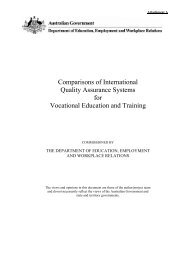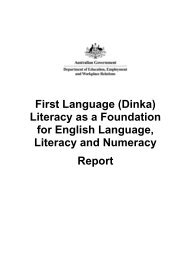Contents
Contents
Contents
You also want an ePaper? Increase the reach of your titles
YUMPU automatically turns print PDFs into web optimized ePapers that Google loves.
Hands 2: Community, Facilitator Guide 15<br />
<br />
Activity 1: Sharing and talking about culture<br />
Maintaining one’s culture, values and traditions is beyond price. Human<br />
beings cannot live without that. We are glad to share our culture with<br />
Europeans and other migrants but we will never give them up.<br />
Getano Lui, jnr Thursday Island, 1994<br />
(Australian Museums online Indigenous site)<br />
• The purpose of this activity is to develop writing and oral<br />
communication skills by celebrating an individual’s connection<br />
to an aspect of their culture that the individual is comfortable<br />
sharing with others.<br />
• Ask learners to think about something that they can identify<br />
within their culture that is important to them. Some of these<br />
things may be tangible objects – e.g. places, objects, artwork,<br />
songs, language – which can be described and named; some may<br />
be intangibles – e.g. relationships, family, spiritual knowledge,<br />
memories.<br />
• Ask them to work in groups of 2–3 and discuss these things. One<br />
person per group could be the writer and each group could list<br />
these things and share their list with those of others. The purpose<br />
of this is to include a broad range of possibilities.<br />
• The teacher can write up a list of these things as the groups<br />
contribute their ideas.<br />
• Discuss with learners: ‘What it is that makes a culture special,<br />
unique?’ ‘What do they think is most important?’ ‘In what way are<br />
these things linked to each other?’<br />
• Ask learners to bring to class something that is important to them<br />
and that links them to their culture. Assure learners that this what<br />
they choose needs to be something that they are happy and feel<br />
comfortable sharing and explaining to others<br />
• Discuss possibilities: these could be real items, such as food,<br />
artwork (or photos of it), or less tangible items such as family<br />
relationships. If less tangible, how could it be shown? E.g. a family<br />
relationships might be shown in a family photo, a special place<br />
by a photo, map, rock, earth. Songs could be used, words of a<br />
language explained, a story told.<br />
• Support learners in organising their presentation. Handout 1 gives<br />
some ideas for guiding the structure to the presentation, but this<br />
will vary according to what is chosen.<br />
• Learners will need some time to prepare for this. Set a date for this<br />
as a cultural sharing/celebrating day.
















